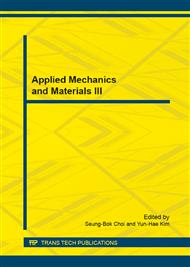p.150
p.162
p.167
p.171
p.176
p.181
p.186
p.190
p.194
Dynamics Simulation of Particles of a Smoke Generator Based on SPH Method
Abstract:
With the increasingly wider use of smoke in informationized warfare, the evaluation of combat effectiveness has become a new research focus in the realm. Hence, there is a need to investigate the dynamics regulation of smoke particles. In this paper, the authors construct a simulation model by analyzing the expanding process of initial smoke cloud. Further, the SPH method was employed in the dynamics simulation. The curves of velocity, displacement and pressure with time were presented after calculation in AUTODYN. The curves from the dynamics simulation show a good consistent when compared to the theoretical model. It proves that the dynamics simulation of smoke particles based on SPH method is feasible.
Info:
Periodical:
Pages:
176-180
Citation:
Online since:
January 2015
Authors:
Keywords:
Price:
Сopyright:
© 2015 Trans Tech Publications Ltd. All Rights Reserved
Share:
Citation:


